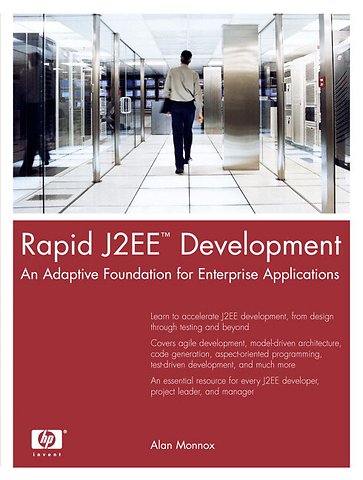


Alan's IT career has quite literally taken him from one side of the world to the other. Starting out in Manchester, England,Alan now works as a Solution Architect for Hewlett-Packard, specializing in the development of bespoke J2EE systems for HP's enterprise customers in the South Pacific.
Meer over Alan MonnoxRapid J2EE Development: An Adaptive Foundation for Enterprise Applications
Samenvatting
Learn to accelerate J2EE development, from design through testing and beyond.
Covers agile development, model-driven architecture, code generation, aspect-oriented programming, test-driven development, and much more.
An essential resource for every J2EE developer, project leader, and manager.
J2EE is today's premier platform for enterprise-level development, but it's difficult to deliver J2EE solutions as quickly as today's businesses need them. This book presents a complete, practical foundation for rapid development throughout your entire project lifecycle. Its best-practice techniques and tools don't just accelerate development they help you adapt smoothly to increasing complexity and non-stop change. You'll learn how to make the most of iterative development, model-driven architecture (MDA), code-generation tools, aspect-oriented programming (AOP), test-driven development, and much more.
Coverage includes:
- Defining end-to-end J2EE development strategies that promote speed without compromising quality
- Understanding how your design-time decisions impact overall project schedules
- Building agile application architectures that promote rapid development
- Using UML modeling to streamline system design and validation
- Speeding database development with code generation and object-relational mapping
- Practical test-driven development: constructing automated unit test suites and using mock objects to "test from the inside out"
- Leveraging the full value of Eclipse and other IDEs
If you're a J2EE developer, project leader, or manager, you're under constant pressure to deliver quality applications more rapidly. Rapid J2EE Development gives you all the skills and resources you need to respond.
Specificaties
Inhoudsopgave
Acknowledgments.
About the Author.
I. ADAPTIVE PROCESSES.
1. A J2EE Adaptive Foundation.
The Need for Rapid Development
The Enterprise Challenge
The J2EE Platform
Defining an Adaptive Foundation
Laying the Foundations for Rapid Development
Foundation Investment Benefits
Critical Success Factors
Summary
2. Rapid Application Development.
Common Elements of RAD
Working with Prototypes
Summary
3. Embracing Adaptive Methods.
Why Use a Methodology?
The Waterfall Lifecycle Model
Iterative Development
Introducing RUP
Agile Methods
Introducing XP
Summary
II. AGILE ARCHITECTURES.
4. Designing for Rapidity.
Architecture and Design Objectives
RAD Architecture and Design
Approaches to J2EE Architecture
Summary
5. Modeling Software.
Why Model?
Multiple Views of Architecture
The Unified Modeling Language
Common Failings
Modeling Tools
Why Modeling Tools Fail
Succeeding with Modeling Tools
Summary
6. Code Generation.
What Is Code Generation?
Passive Code Generators
Active Code Generators
Attribute-Oriented Programming
Introducing Xdoclet
Working with Actively Generated Code
Summary
7. Rapidity and the Database.
The Database Dilemma
Data Access Options
Code Generation and O/R Mapping
Setting Up the Database
Generating the Persistence Layer
Summary
8. Model-Driven Architecture.
The Promise of MDA
MDA Explained
MDA Versus Traditional Modeling
MDA Compliant Tools
MDA with AndroMDA
Summary
III. RAPID LANGUAGES.
9. Scripting.
Why Use a Scripting Language?
Features of a Scripting Language
Introducing Jython
A Groovy Alternative
Summary
10. Working to Rule.
Business Rules
Business Rules in Software
Rule Engines
Introducing Jess
The Java Rule-Engine API
Enterprise-Level Rule Engines
Summary
11. Aspect-Oriented Programming.
Why AOP?
AOP Explained
Introducing AspectJ
Language Versus Framework
Introducing AspectWerkz
Adopting Aspects
Summary
IV. DYNAMIC ENVIRONMENTS.
12. Optimal Builds.
Time and Motion
The Build Process
Introducing Ant
Minimal Builds with Ant
Working with Subprojects
Viewing Build Dependencies
Standard Build Targets
Project Organization
Integration with IDEs
Extending Ant with Jython
Summary
13. The Integrated Development Environment.
Why Use an IDE?
Introducing Eclipse
IDE Features for Enterprise Development
Debugging J2EE Applications with Eclipse
Summary
14. Test-Driven Development.
Testing as a Development Paradigm
Introducing Junit
Generating Unit Tests
Testing from the Inside Out
Summary
15. Efficient Quality Assurance.
Quality Assurance
Automated Testing
Functional Testing
Introducing HttpUnit
Load and Stress Testing
Introducing Jmeter
JMeter Guidelines
Summary
Appendix A. Acronyms.
Appendix B. Bibliography.
Index.
Anderen die dit boek kochten, kochten ook
Net verschenen
Rubrieken
- aanbestedingsrecht
- aansprakelijkheids- en verzekeringsrecht
- accountancy
- algemeen juridisch
- arbeidsrecht
- bank- en effectenrecht
- bestuursrecht
- bouwrecht
- burgerlijk recht en procesrecht
- europees-internationaal recht
- fiscaal recht
- gezondheidsrecht
- insolventierecht
- intellectuele eigendom en ict-recht
- management
- mens en maatschappij
- milieu- en omgevingsrecht
- notarieel recht
- ondernemingsrecht
- pensioenrecht
- personen- en familierecht
- sociale zekerheidsrecht
- staatsrecht
- strafrecht en criminologie
- vastgoed- en huurrecht
- vreemdelingenrecht





